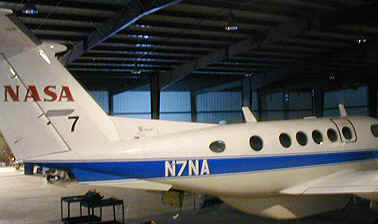The NASA King Air 200
Just in case you didn't know, NASA stands for National
Aeronautics & Space Administration. NASA has sent scores of folks into
space, to the moon and launched space ships to explore the galaxy. No doubt, to travel the distances the space vehicles do and
carry people into space, one would expect they would be the Mecca of
electronics. In fact, NASA was the pioneer in many of the aviation electronics
we use today. Looking at the logo on the tail, it's obvious NASA has the keys
to this nice King Air 200. One probably would fantasize about the modern
avionics that "must" be in the panel. Heads up displays, zero/zero automatic
landing system, TCAD V, TAWS 16, radar altimeters that are accurate within two
centimeters. While we can't see the panel in this picture, we know it's total
glass and more blinking lights than a southern town at Christmas time.
No doubt, to travel the distances the space vehicles do and
carry people into space, one would expect they would be the Mecca of
electronics. In fact, NASA was the pioneer in many of the aviation electronics
we use today. Looking at the logo on the tail, it's obvious NASA has the keys
to this nice King Air 200. One probably would fantasize about the modern
avionics that "must" be in the panel. Heads up displays, zero/zero automatic
landing system, TCAD V, TAWS 16, radar altimeters that are accurate within two
centimeters. While we can't see the panel in this picture, we know it's total
glass and more blinking lights than a southern town at Christmas time.
So, why is the aircraft in the Avionics West hanger you ask?
Is it there for changing of a burned out light bulb or maybe inside for safe
keeping? Not really, you see, NASA has some of the best pilots I've ever been
around but the avionics in their King Air 200's is dated. They decided the old
VHF-20 series Pro-Line just wouldn't cut it nowadays. The old radar didn't show
much, in fact a blind man had a better chance of spotting weather than the old
radar did. After months of stopping by the shop and playing with GNS530 and
CNX80, they decided the trusty GNS530 was the way to go.
Most of the old Collins Pro-Line avionics will be departing
the pattern along with the radar. Steve and the boys will be installing a new
Honeywell RDR2000 color radar. Panel room is scarce even in a big aircraft like
this 200; thus they elected to add the Garmin AT MX20 MFD to display the weather
from the radar and the WSI. Yes, two different weather systems will be aboard
for pilots to aid in making the flight safer. Speaking of safer, the MX20 has
Terrain to aid in keeping the aircraft out of the dirt and the SkyWatch TCAD
will help the crew from meeting other aircraft in the air. The Garmin GTX330
Mode S transponder will go into the panel also. Dual GNS530's will take up the
rest of the room. The autopilot flight director, ADF (yes they kept the thing),
DME will stay in the aircraft. To help with interfacing the modern equipment
with some of the older equipment such as the RMI's two GAD42's will be
installed. The current audio system will remain in the aircraft due to the fact
this King Air's audio system is better than anything else out there today.
Now the question is, why did NASA pick Avionics West for
their installation? Bet you already know the answer to that.
 No doubt, to travel the distances the space vehicles do and
carry people into space, one would expect they would be the Mecca of
electronics. In fact, NASA was the pioneer in many of the aviation electronics
we use today. Looking at the logo on the tail, it's obvious NASA has the keys
to this nice King Air 200. One probably would fantasize about the modern
avionics that "must" be in the panel. Heads up displays, zero/zero automatic
landing system, TCAD V, TAWS 16, radar altimeters that are accurate within two
centimeters. While we can't see the panel in this picture, we know it's total
glass and more blinking lights than a southern town at Christmas time.
No doubt, to travel the distances the space vehicles do and
carry people into space, one would expect they would be the Mecca of
electronics. In fact, NASA was the pioneer in many of the aviation electronics
we use today. Looking at the logo on the tail, it's obvious NASA has the keys
to this nice King Air 200. One probably would fantasize about the modern
avionics that "must" be in the panel. Heads up displays, zero/zero automatic
landing system, TCAD V, TAWS 16, radar altimeters that are accurate within two
centimeters. While we can't see the panel in this picture, we know it's total
glass and more blinking lights than a southern town at Christmas time.